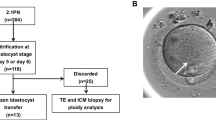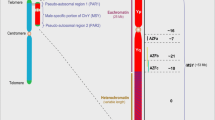Abstract
Purpose
Tubulin beta eight class VIII (TUBB8) is essential for oogenesis, fertilization, and pre-implantation embryo development in human. Although TUBB8 mutations were recently discovered in meiosis-arrested oocytes of infertile females, there is no effective therapy for this gene mutation caused infertility. Our study aims to further reveal the infertility-causing gene mutations in the patient’s family and to explore whether the infertility could be rescued by optimizing the conditions of embryo culture and finally achieve the purpose of making the patient pregnant.
Methods
Whole-exome sequence analysis and Sanger sequencing were performed on patients’ family members to screen and identify candidate mutant genes. Construction of plasmids, in vitro transcription, microinjection of disease-causing gene cRNA, and immunofluorescence staining were used to recapitulate the infertility phenotype observed in patients and to understand the pathogenic principles. Simultaneously, overexpression of mutant and wild-type cRNA of the candidate gene in mouse oocytes at either germinal vesicle (GV) or metaphase II (MII) stage was performed in the rescue experiment.
Results
We first identified a novel heritable TUBB8 mutation (c.1041C>A: p.N347K) in the coding region which specifically affects the first mitosis and causes the developmental arrest of early embryos in a three-generation family. We further demonstrated that TUBB8 mutation could lead to abnormal spindle assemble. And moreover, additional expression of wild-type TUBB8 cRNA in the mouse oocytes in which the mutant TUBB8 were expressed can successfully rescue the developmental defects of resulting embryo and produce full-term offspring.
Conclusions
Our study not only defines a novel mutation of TUBB8 causing the early cleavage arrest of embryos, but also provides an important basis for treating such female infertility in the future.





Similar content being viewed by others
References
Edwards RG, Bavister BD, Steptoe PC. Early stages of fertilization in vitro of human oocytes matured in vitro. Nature. 1969;221(5181):632–5.
Li R, Albertini DF. The road to maturation: somatic cell interaction and self-organization of the mammalian oocyte. Nat Rev Mol Cell Biol. 2013;14(3):141–52. https://doi.org/10.1038/nrm3531.
Kimura N, Hoshino Y, Totsukawa K, Sato E. Cellular and molecular events during oocyte maturation in mammals: molecules of cumulus-oocyte complex matrix and signalling pathways regulating meiotic progression. Society of Reproduction and Fertility supplement. 2007;63:327–42.
Vogt E, Kirsch-Volders M, Parry J, Eichenlaub-Ritter U. Spindle formation, chromosome segregation and the spindle checkpoint in mammalian oocytes and susceptibility to meiotic error. Mutat Res. 2008;651(1–2):14–29. https://doi.org/10.1016/j.mrgentox.2007.10.015.
Coticchio G, Dal Canto M, Mignini Renzini M, Guglielmo MC, Brambillasca F, Turchi D, et al. Oocyte maturation: gamete-somatic cells interactions, meiotic resumption, cytoskeletal dynamics and cytoplasmic reorganization. Hum Reprod Update. 2015;21(4):427–54. https://doi.org/10.1093/humupd/dmv011.
Albertini DF. Regulation of meiotic maturation in the mammalian oocyte - interplay between exogenous cues and the microtubule cytoskeleton. Bioessays. 1992;14(2):97–103. https://doi.org/10.1002/bies.950140205.
Mehlmann LM. Stops and starts in mammalian oocytes: recent advances in understanding the regulation of meiotic arrest and oocyte maturation. Reproduction. 2005;130(6):791–9. https://doi.org/10.1530/rep.1.00793.
Pellestor F, Anahory T, Andreo B, Hedon B, Hamamah S. Maternal aging and aneuploidy: lessons from human oocytes. Fertil Steril. 2004;82:S281–S2.
Mullen TJ, Davis-Roca AC, Wignall SM. Spindle assembly and chromosome dynamics during oocyte meiosis. Curr Opin Cell Biol. 2019;60:53–9. https://doi.org/10.1016/j.ceb.2019.03.014.
Feng R, Yan Z, Li B, Yu M, Sang Q, Tian G, et al. Mutations in TUBB8 cause a multiplicity of phenotypes in human oocytes and early embryos. J Med Genet. 2016;53(10):662–71. https://doi.org/10.1136/jmedgenet-2016-103891.
Feng RZ, Sang Q, Kuang YP, Sun XX, Yan Z, Zhang SZ, et al. Mutations in TUBB8 and human oocyte meiotic arrest. New Engl J Med. 2016;374(3):223–32. https://doi.org/10.1056/NEJMoa1510791.
Chen B, Li B, Li D, Yan Z, Mao X, Xu Y, et al. Novel mutations and structural deletions in TUBB8: expanding mutational and phenotypic spectrum of patients with arrest in oocyte maturation, fertilization or early embryonic development. Hum Reprod. 2017;32(2):457–64. https://doi.org/10.1093/humrep/dew322.
Chen B, Wang W, Peng X, Jiang H, Zhang S, Li D, et al. The comprehensive mutational and phenotypic spectrum of TUBB8 in female infertility. Eur J Hum Genet. 2019;27(2):300–7. https://doi.org/10.1038/s41431-018-0283-3.
Yuan P, Zheng LY, Liang H, Li Y, Zhao HJ, Li RQ, et al. A novel mutation in the TUBB8 gene is associated with complete cleavage failure in fertilized eggs. J Assist Reprod Gen. 2018;35(7):1349–56. https://doi.org/10.1007/s10815-018-1188-3.
Huang L, Tong X, Luo L, Zheng S, Jin R, Fu Y, et al. Mutation analysis of the TUBB8 gene in nine infertile women with oocyte maturation arrest. Reprod BioMed Online. 2017;35(3):305–10. https://doi.org/10.1016/j.rbmo.2017.05.017.
Xiang J, Wang W, Qian C, Xue J, Wang T, Li H, et al. Human oocyte maturation arrest caused by a novel missense mutation in TUBB8. J Int Med Res. 2018;46(9):3759–64. https://doi.org/10.1177/0300060518778638.
Wang AC, Zhang YS, Wang BS, Zhao XY, Wu FX, Zhai XH, et al. Mutation analysis of the TUBB8 gene in primary infertile women with arrest in oocyte maturation. Gynecol Endocrinol. 2018;34(10):900–4. https://doi.org/10.1080/09513590.2018.1464138.
Chen BB, Zhang ZH, Sun XX, Kuang YP, Mao XY, Wang XQ, et al. Biallelic mutations in PATL2 cause female infertility characterized by oocyte maturation arrest. Am J Hum Genet. 2017;101(4):609–15. https://doi.org/10.1016/j.ajhg.2017.08.018.
Xiang JJ, Wang W, Qian CF, Xue JY, Wang T, Li HB, et al. Human oocyte maturation arrest caused by a novel missense mutation in TUBB8. J Int Med Res. 2018;46(9):3759–64. https://doi.org/10.1177/0300060518778638.
Wang A-C, Zhang Y-S, Wang B-S, Zhao X-Y, Wu F-X, Zhai X-H, et al. Mutation analysis of the TUBB8 gene in primary infertile women with arrest in oocyte maturation. Gynecol Endocrinol. 2018;34(10):900–4. https://doi.org/10.1080/09513590.2018.1464138.
Liu W, He X, Yang S, Zouari R, Wang J, Wu H, et al. Bi-allelic mutations in TTC21A induce asthenoteratospermia in humans and mice. Am J Hum Genet. 2019;104(4):738–48. https://doi.org/10.1016/j.ajhg.2019.02.020.
Chen BB, Wang WJ, Peng XD, Jiang HF, Zhang SZ, Li D, et al. The comprehensive mutational and phenotypic spectrum of TUBB8 in female infertility. Eur J Hum Genet. 2019;27(2):300–7. https://doi.org/10.1038/s41431-018-0283-3.
Sang Q, Li B, Kuang Y, Wang X, Zhang Z, Chen B, et al. Homozygous mutations in WEE2 cause fertilization failure and female infertility. Am J Hum Genet. 2018;102(4):649–57. https://doi.org/10.1016/j.ajhg.2018.02.015.
Funding
This project was supported by the National Natural Science Foundation of China (81630035, 31721003, 31601177, 31501197, 31501183, 81671521, and 31430056), the Ministry of Science and Technology of China (Grants 2016YFA0100400, 2015CB964800, 2018YFC1003102, 2014CB964601, 2016YFC1000600, and 2015CB964503), the Shanghai Natural Science Foundation (Grant 16ZR1427200), the Western Medicine Guidance Project of Shanghai Science and Technology Commission (1741196), the Youth Innovation Promotion Association of Chinese Academy of Sciences [2020104 to C.Z.], the Shanghai Shenkang Clinical Innovation Three-year Action Plan Project (16CR3069B).
Author information
Authors and Affiliations
Corresponding authors
Ethics declarations
Conflict of interest
The authors declare that they have no conflict of interest.
Ethical approval
This study was performed in line with the principles of the Declaration of Helsinki. Approval was granted by the Ethics Committee of Shanghai First Maternity and Infant Hospital of Tongji University.
Consent to participate
All subjects participating in this study signed their informed consents.
Additional information
Publisher’s note
Springer Nature remains neutral with regard to jurisdictional claims in published maps and institutional affiliations.
Electronic supplementary material
ESM 1
(DOC 92 kb)
Rights and permissions
About this article
Cite this article
Jia, Y., Li, K., Zheng, C. et al. Identification and rescue of a novel TUBB8 mutation that causes the first mitotic division defects and infertility. J Assist Reprod Genet 37, 2713–2722 (2020). https://doi.org/10.1007/s10815-020-01945-w
Received:
Accepted:
Published:
Issue Date:
DOI: https://doi.org/10.1007/s10815-020-01945-w




